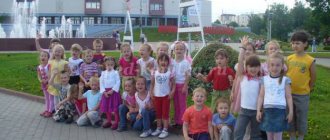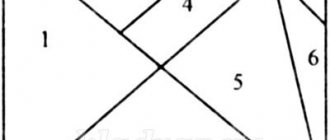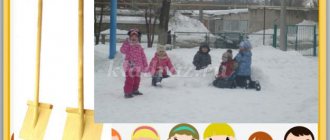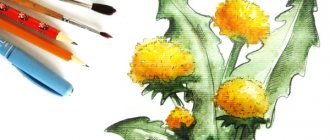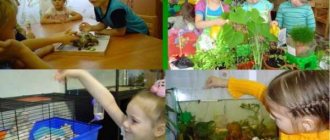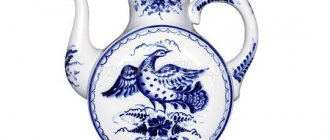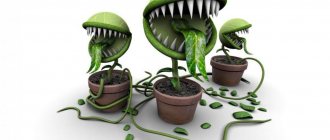Organization of independent activities of older preschoolers
By the age of 5–6 years, important changes occur in the behavior and quality of children’s mental and physical actions. This is due to the formation of the basic processes of the nervous system, the development of various types of memory and thinking abilities. When preparing conditions for independent activity and thinking through methods for organizing children's activities, the teacher of the senior group takes into account the age characteristics of the students:
- In children 5–6 years old, attention is more stable than in younger preschoolers. At this age, the basic processes of the nervous system improve, self-regulation of behavior occurs, and children are less likely to become overtired. Children are able to observe any object or process for a long time, create large-scale buildings from a construction set, and assemble a mosaic from a significant number of parts.
- Children are capable of intentional memorization. Listening to the teacher’s explanations and instructions, students record the stages and methods of action in their memory and reproduce them later in independent studies: for example, they conduct experiments in the research corner or create crafts in the creativity center.
- The intellectual capabilities of children are improved. At the age of 5–6 years, a child quickly makes assumptions and predicts the results of actions. He independently establishes cause-and-effect relationships and navigates the temporal and spatial relationships of objects. Conscious experimentation, independently planned and executed, becomes possible. If a child wants to experiment with substances, he must first tell the teacher the safety rules. The teacher observes from the sidelines the children’s independent experimentation in the mini-laboratory.
- Cognitive interests expand, children study distant objects: planets, spaceships, the depths of the sea, dinosaurs, and children create drawings based on new information. Gaming activities become more complex: role-playing games are built according to rules discussed in advance, and roles are distributed among the participants.
- Fine motor skills are developed, children work and play with small objects: they assemble construction sets from small parts, make jewelry from beads and seed beads.
- Children willingly cooperate within the group. They like to independently choose partners for experiments, games and conversations, and discuss topics that interest them.
Older preschoolers are able to cooperate with each other during research and play activities
The development of independence is one of the conditions of the educational process in preschool educational institutions, aimed at raising a comprehensively developed personality. The Federal State Educational Standard (FSES) does not call children’s independent activities as a separate area of learning and pays more attention to the joint work of the teacher and students. However, the target for each developmental area (cognitive, physical, social-communicative, speech, artistic and aesthetic) is to encourage initiative in children's activities (mental or practical), stimulate independence in choosing methods of activity and their implementation. Forming a research type of thinking and creating positive motivation for creative solutions to problem situations creates a solid basis for successful learning at school. The goal of organizing independent activities in kindergarten is to develop the child as an independent creator and researcher.
Developing the skill of independently searching for information is one of the target foundations of education in preschool educational institutions
Tasks of organizing independent activities in the senior group
- Formation of strong-willed qualities: psychological resistance to the influence of external factors (street noise, voices of other children) and other people’s opinions, the desire to bring the plan to the final result. Older preschoolers begin to develop the ability for self-analysis and evaluation of completed actions.
- Improving self-regulation processes: the ability to calculate energy expenditure to perform planned actions, feel the need to change the type of activity or rest. At the age of 5–6 years, the processes of the nervous system actively develop: the child has perseverance, reacts positively to advice and constructive comments.
- Development of the ability to independently construct a game plan, observation, research, employment, the desire to implement ideas without the help of adults.
- Strengthening self-care skills. The actions of dressing and undressing, observing the rules of personal hygiene and cleanliness of the room should be brought to automaticity.
- Development of independence through carrying out work assignments: duty in the dining room, play area, bedroom, etc.
When planning classes for the development of independent activity, the age and individual characteristics of children, their interests and passions, consistency with thematic planning for educational activities and creative activities, and the material base for play and children's experimentation are taken into account. The subject-spatial environment in the group room should be developmental. Children receive positive emotions from independent activity and acquire new knowledge about the properties of objects and the connections between them. This environment is organized by the teacher, and children are free to choose ways of acting in its conditions. The principles of functioning of children's activity centers: accessibility, safety, enrichment with temporary materials (for example, in the center of cognitive activity you can organize an exhibition for Cosmonautics Day, in a corner of nature in the spring you can display boxes with bulbs of hyacinths or tulips, supplement the play area with a set of road signs while studying traffic rules on ECD classes and walks).
Drawing up a duty schedule - a technique for developing self-service skills through work assignments
Forms of organization of the subject-spatial environment
- Center for educational and research activity: science center, knowledge corner, experimental workshop, laboratory, experimentarium. Equipped with a selection of encyclopedias and albums with educational illustrations, diagrams, cards, models and figures of objects to study, materials (including natural ones) and tools for conducting experiments. Before independently conducting any experiment in the laboratory, students must seek permission from the teacher and first discuss the safety rules. For public holidays and events in the kindergarten, temporary exhibitions are organized in the research corner: “Taking care of the planet”, “Secrets of the Solar system”, “Structure of a volcano”, “How primitive people lived”.
At the center of cognitive and research activities, students participate in the search for new knowledge
- Game center: areas with sets of toys and costumes for role-playing games (“Traffic officer and drivers”, “Hospital”, “Grocery store”, “Kitchen”), a center for educational games (shelves with board and educational games, puzzles). To consolidate and improve self-service skills, play corners are supplemented with materials on relevant topics: clothes for toys with various types of fasteners, items for acting out problem situations (“Who made a mess in the kitchen”, “Doll Katya, put things in order in the closet”, “The bear is going to the kindergarten").
In a playful way, children reproduce what they have learned during classes
- Sports section. The physical activity center can be equipped with special equipment: hoops, balls of different sizes, jump ropes, elastic bands for jumping, sets for playing small towns, skittles.
The physical activity center provides children with equipment for outdoor games and exercises
- Center for environmental activities: a corner of nature, a living corner, a winter garden, a mini-vegetable garden (boxes with soil on the windowsill for growing herbs and vegetables). Pupils of the senior group independently conduct long-term observations of plant growth, engage in labor activities with knowledge of the characteristics of representatives of the plant world: water, moisten leaves, loosen the soil, monitor the light and temperature conditions in a corner of nature.
Senior preschoolers independently care for plants in a group
- Center for art/artistic and aesthetic activities: a corner of art or folk crafts (reproductions of paintings, small copies of architectural and sculptural objects, toys, dishes and interior items in folk style), a theater corner (scenery for staging fairy tales, puppet and finger theater, masks and character costumes for children, face painting), a productive creativity zone (materials for modeling, drawing, paper construction, including origami), a musical island (a collection of audio recordings - children's and holiday songs, sounds and voices of nature with instrumental accompaniment, musical instruments - xylophone, tambourine, children's synthesizer, castanets, balalaika, etc.).
Dramatizing episodes of favorite stories and improvising in acting out various plots is one of the forms of independent activity of preschoolers
- Psychological comfort center: relaxation corner, quiet zone, magic room (tent, marquee, hammock, sofas where children can relax and chat quietly). Children independently choose ways to relax: looking at a book, quietly playing with a doll, calm conversation with each other.
In the group it is necessary to organize a place where the child can be a little quiet and relax
Types of independent activities of older preschoolers: table
| Type of independent activity | Forms of implementation |
| Research | In the modern world, it is important to teach a child not only to assimilate and accumulate ready-made information, but also to develop the ability and desire for independent knowledge. Through visual observation, tactile contact and sound perception, children can learn new things about objects. A small, but independently made discovery causes delight in a child and a desire to gain new knowledge. Older preschoolers conduct research consciously. They make observations in a corner of nature, a science center, during a walk and conduct experiments in a mini-laboratory. The teacher is always ready to answer the children’s questions. |
| Gaming | Children independently act out scenes from fairy tales, cartoons, or everyday situations using toys. By older preschool age, there is a difference in the themes of games between boys and girls: boys play with cars, soldiers, robots, build fortresses and ships from construction sets, girls prefer to play with dolls, dishes, and plush toys. Children’s play activities are often imitative of people’s professions and social events: “In the store”, “Mothers and daughters”, “Hairdresser” or “Beauty salon”, “Bank”, “In the doctor’s/dentist’s office”, “Traffic officer and pedestrians”, “Playing at kindergarten/school”. |
| Artistic speech | During the school year, children get acquainted with literary works and learn to answer questions about the content of the text and retell the plot. Independent artistic and speech activity is manifested during the staging of fairy tales in the theater corner, where there are scenery, costumes, and masks of familiar fairy tales. The teacher can encourage the children in the play area to take action by placing in the corner a set for a finger or puppet theater based on the fairy tale they have studied. The ability of artistic retelling is realized in students’ conversations with each other, when they want to share a particularly liked episode of a work of art. |
| Motor | For older preschoolers, physical activity is realized in role-playing outdoor games: “Polar bears on an ice floe”, “Mousetrap”, “Hares and Hunters”, “Don’t stay on the floor”, “Cossacks-robbers”, “The sea is worried - once!” etc. Girls learn to jump rope and rubber band in a variety of ways. Boys love to play football. |
| Artistic | Creating visual images using paints, paper, plasticine, and natural materials. Children's creative works reflect their ideas about objects. Mastering the techniques of drawing with pencil and paints, sculpting and appliqué, the child begins to feel the desire not just to show, but to do beautifully. Preschoolers love to draw in their free time! The older group children have a plot in their drawings. Their drawings are a vision of objects and situations and an attitude towards them at the same time. What caused bright, positive emotions, the child tries to convey colorfully and positively. The corners of developmental activities must certainly contain a variety of materials for children's crafts, decorations for finished works: threads, beads, sequins, stickers, natural and waste materials, buttons, pebbles, shells, ribbons, postcards, glitter. |
| Labor education | The best incentive for preschoolers to work independently is an example before their eyes. The children willingly help the teacher in cleaning the territory of the kindergarten or group room, take care of the plantings on the site, and clear the paths and benches of snow in winter. The introduction of a duty schedule improves the ability to take a responsible approach to instructions from seniors and try to complete the work efficiently. Visual material in the form of printed algorithms on the wall motivates children 5–6 years old to independently cope with the task (arrange cutlery and dishes) and then compare their actions with the given scheme, evaluate the result - whether everything was done correctly. Older preschoolers love to help the younger ones: take them from the gym to the group, fasten their clothes, dry themselves, etc. |
| Environmental education | Caring for nature is a valuable personality trait in the modern world. Children enjoy caring for plants in the nature center and on the site, feeding animals and birds. |
| Self-service | Self-care involves the child mastering hygiene standards and how to comply with them (washing, washing hands after a walk and before eating, brushing teeth, taking a shower), mastering the skill of dressing and undressing, the culture of eating and rules of behavior at the dinner table. Self-care is considered the main type of work activity for preschoolers; it allows children to feel independent from an adult. In older preschool age, the skill of monitoring one’s appearance and the order of the surrounding environment, and following the rules of hygiene are consolidated. |
Game activity remains one of the leading types of activity in older preschool age
Motivating start to class
Children's independent activity manifests itself in various routine moments during the day: upon arrival at the garden in the morning, on a walk, during leisure time in the afternoon. In order for children to be able to use their imagination and a set of skills to occupy themselves in their free time in employment centers, the teacher must achieve the effectiveness of children's activity during educational classes. Interacting with students, the teacher, by directly showing verbal instructions, forms and develops in the students the ability to highlight the main thing - a question or problem. Those activities will be the most interesting and productive, which were aimed at achieving a specific result (making crafts, experimenting, compiling a completed story from pictures, completing a work assignment, playing a sports game). Having mastered the algorithm of actions and methods of implementation, children transfer the forms of activity worked out with the teacher into individual activity.
It is important not to occupy the time allocated for children's games with other activities. Play for older preschoolers still remains a way to consolidate practical skills, relieve mental stress, and interact with peers.
A game for preschoolers is not only entertainment, but also a form of communication
The structure of independent activity of preschoolers consists of three stages:
- motive,
- action,
- result.
The role of the teacher is to create motivation for further actions of students in the conditions of the subject-spatial environment organized by the teacher. The desire to work independently can be of different natures: playful, cognitive, volitional, social and emotional. Creating a friendly and trusting atmosphere is an indispensable condition for the children’s successful activities. The teacher makes sure that each child is in a good mood before and during the lesson. The social orientation of motives for work is expressed in a positive attitude towards collective activity, the desire to discuss what is being studied or created, and the ability to listen to the opinions and desires of classmates. Volitional motivation means the direction of a child’s actions towards achieving a specific goal, interest in demonstrating his abilities. Playful and educational motives often arise spontaneously, but the teacher can initiate these types of motivation by predicting the independent activities of students within the framework of thematic planning.
Using a motivational start to the lesson, the teacher predicts children’s independent activity in games
| Motivating start to class | Predicted independent activity of pupils |
| Studying visual material. The teacher examines with the children a model of the earth in prehistoric times: dinosaurs reign on earth, in water and in the sky. The guys name the differences between ancient lizards and determine the structural features (plates, spines, partial plumage, powerful claws). | Search for information, expanding ideas about dinosaurs in the cognitive center: consideration of an illustrated encyclopedia. Game with dinosaur figures. |
| Conducting a conversation. — Guys, what do we do before we sit down at the dinner table? - Wash your hands. - Why are we doing this? — To wash away dirt, to protect yourself from germs from unwashed hands entering the body while eating. — When else during the day should you wash your hands and face? — In the morning after waking up, upon returning from the street, after working with dirty materials or playing with pets, before going to bed. | Playing with dolls and a washbasin, stylized as Moidodyr from the poem by K. I. Chukovsky. |
| Conducting an experiment. The teacher demonstrates the ability of salt to dissolve in water. | Research activities in an experimental laboratory to expand understanding of the ability of substances to dissolve in water (sugar, food coloring, sand, clay). |
| Surprise moment. The group receives a package from a fairy-tale character, in which the students find a kit for creating a puppet theater. | Dramatization in a playful form of fairy tales known to the pupil (“Teremok”, “Kolobok”, “The Hare and the Fox”, “The Fox and the Wolf”). |
| Reading poems, riddles. The teacher asks the children riddles about toys and for each correct answer reads the corresponding poem by A. Barto from the “Toys” series. | Activity in the play area with artistic and speech activities. |
| Attraction to the game. The teacher shows the children a rubber band and asks what methods of jumping over it and game options they know (“Olympics, mom’s lipstick,” “Confusion,” etc.). Instead of a rubber band, you can offer jump ropes for the game. | Outdoor games with a rubber band. |
If you invite children to show how they can play with a familiar object, they are drawn into the game
Examples of independent activities in the senior group of kindergarten
We invite you to familiarize yourself with the options for independent activity of older preschoolers in various regime moments.
Role-playing game “Polyclinic”: video
Senior game - free activity (outdoor game): video
Game activities on traffic rules: video
Conditions for organizing independent activities during a walk: video
Theatrical activities: video
Independent activities (didactic games): video
Corner of solitude in the senior group: video
Self-care lesson in the senior group of kindergarten
Children 5–6 years old have well-developed fine motor skills and coordination of movements. They master the skill of dressing and undressing, and remember the sequence of actions. Children are familiar with the rules of personal hygiene. While eating, older preschoolers skillfully handle cutlery. At this age, more attention should be paid to the rules of behavior at the table, strengthening the skill of monitoring one’s appearance, the condition of the working and sleeping space.
At older preschool age, children understand the teacher's instructions and follow verbal instructions. Self-care is recognized by methodological research as the simplest and at the same time one of the main elements of a child’s work activity. Examples of work assignments for self-service: “Pull away the dishes and tidy up the table”, “Please turn your turtleneck inside out and hang it up to dry”, “Vova, your shoelace is untied, sit on the bench and tie a bow”, “Katya, in front of During the dance class, you need to tie your hair up with an elastic band/braid it.” The first self-service instructions should be presented visually, for example, in the form of mnemonic cards - a sequence of pictures on a specific topic.
In the older group, you can draw up a duty schedule in order to develop in the children the ability to set the table, monitor order and cleanliness in the dining and play areas, bedroom, and locker room. Positive emotions come from being on duty in a corner of wildlife, where the children are tasked with monitoring the condition of animals and plants and caring for them.
The children enjoy watching plants and animals and carrying out tasks to care for them.
Card index of topics on developing self-service skills: table
| Self-Care Topic | Educational and training tasks | Techniques for independent activities of children |
| "Eating" | Strengthening the skills of cultural eating and handling cutlery. Cultivating a sense of neatness: take garbage to a specially designated place, check the cleanliness of the table after finishing the meal. Conscientiously perform the duties of cafeteria attendants. | Games with doll dishes and toys, didactic games for learning the rules of cultural eating, carrying out work assignments while on duty. |
| "Dressing and Undressing" | Generalization and consolidation of the skills of consistent dressing and undressing, neat hanging and folding of removed items. Improving the ability to cope with different types of fasteners and laces. | Games for fine motor skills with fasteners, didactic games for memorizing the algorithm for the correct sequence of actions when dressing/undressing, games with doll clothes. |
| "Rules of personal hygiene" | Strengthening cultural and hygienic skills: using the bathroom and toilet, washbasin, handkerchief. Consolidation of dental care skills (teeth brushing algorithm, use of dental floss). | Conducting conversations about the importance of maintaining hygiene rules, the need to take care of your body, conducting training games like “Teach your baby how...”. |
| “Keeping shoes and clothes, sleeping place, work tools, etc. in order.” | Improving the skill of noticing and independently eliminating disorder in your appearance (correcting your hair, clothes, cleaning your shoes in a timely manner). Consolidating the skill of making the bed, keeping the bed clean and tidy. Fostering a caring attitude towards things: items of clothing and shoes, accessories, work tools (pencils, brushes, outdoor equipment), toys, books. Involvement in general cleaning of the premises. | Conducting game trainings “Hairstyles”, “Describe how a friend is dressed”, didactic games “Name what is wrong in the character’s appearance”, “What is out of place”, competitions for the neatest workplace/locker. |
Older preschoolers need to be taught to conscientiously perform the duties of the duty officer
Summary of a self-care lesson in the senior group on the topic “Water is our good friend”: table
| Goals | 1. To consolidate children’s knowledge about the rules of personal hygiene (hand care). 2. Consolidate knowledge about hand skin care products. 3. Consolidate knowledge about the hand washing algorithm. 4. Introduce children to the three “golden” rules for hand care: wash hands after using the toilet, after a walk, before eating. 5. Activate and enrich children’s vocabulary through the use of nursery rhymes, poems, words: transparent, clean, calm. 6. Strengthen the skills of differentiating mouth and nasal breathing (game “It’s time to get up”). 7. Develop communication skills. |
| Preliminary work | 1. Introduction to hand care products. 2. Introducing and reviewing the algorithm and the “Three “golden” rules.” 3. Observations in nature of rain and snow. 4. Conducting experiments with snow, experiments confirming the moisture needs of plants. 5. Work on onomatopoeia: the song of water - s-s-s, rain - drip-drip-drip. 6. Carrying out breathing exercises. 7. Learning nursery rhymes about water. 8. Speech games: “What kind of water?”, “What is water for?” 9. Sensory games to develop thermal sensations: “What kind of water?” 10. Games with water: “Get the toy with a spoon, strainer”, “Find out what it is?” (with eyes closed). 11. Reading fiction: V. Mayakovsky. “What is good and what is bad?”, A. Barto. “Dirty Girl”, K. Chukovsky. "Moidodyr". |
| Material | Items for washing hands, a strainer, a spatula, a watering can, a bucket of water, a doll, a bunny and other toys, algorithms and the “Three “golden” rules.” |
| Progress of the event | Organizing time. The teacher enters the group with the children. Children sit on chairs (“sleep”). Game “It’s time to get up” Teacher (speaks in a whisper). - My children, my children, My children are fast asleep. My children, my children are quietly sniffling. Like this! The teacher takes a noisy breath in through his nose, then exhales through his mouth with the sound ho-o-o-o. Children imitate. Educator (loudly). - Sun is up! Stop sleeping! Stop sleeping! It's time to get up! Children “wake up” and, standing on their toes with their arms raised, take a breath. Then, throwing your arms along your body and lowering yourself onto your full foot, exhale. Educator. - Oh, we woke up! Smile! Hello! (drawn out) Children. - Sun is up! Stop sleeping! Stop sleeping! It's time to get up! Hello! (lingering) Game “Who knows how to wash clean?” Educator. - Today we are going to visit our toys. Let's see if they can be friends with water. We know that... You must wash yourself in the morning, in the evening and during the day, before every meal, after sleep and before going to bed. Knock, knock, who lives here? (Doll Sima!) Life is unbearable for the slob Sima: The doll Sima walks around, Always in a dirty dress, Little brother Mishka is wearing dirty pants, Here is a stocking, and there is a shoe. Is it possible to do this? - Children, which of you knows how to wash yourself? Let's show the toys how to wash themselves properly. The game is accompanied by the movements indicated in the text. Who knows how to wash clean? Who isn't afraid of water? This is us! This is us! This is us! Children raise their hands up. Who doesn't want to be dirty? Wash your ears properly? This is us! This is us! This is us! Children raise their hands up. We know how to wash ourselves. We wash our necks with a washcloth. Like this! Like this! And just like that! Children pretend to rub their neck with a washcloth. And then we’ll wash the head deftly over the basin. Like this! Like this! And just like that! Children pretend to wash their hair. To wash the legs clean, We will wash them a little. Like this! Like this! And just like that! Children pretend to wash their feet. We washed ourselves like big boys, so clean we are. Look! Look! Look! Children clap their hands. 4. Consolidating children’s knowledge about the rules of personal hygiene. -Who lives here? (Bunny.) How white he is, and how clean he is, look: The bunny is washing his face - Getting ready for the kids: He washed his nose, washed his tail. I washed my ear and dried it. “And now we’ll teach Sima how to wash herself.” Let him take an example from the bunny. Sima, wash your face and neck thoroughly with soap, don’t spill the water, wipe your hands dry. - Look, guys, our Sima: She combed her hair and washed her face, bowed to all the kids, she wanted to have fun and dance again. Well, guys, come out. Dance with Sima. Children performing the dance “Ay-da, kids...”. Game "Find the necessary objects." — Guys, find the items necessary for washing your hands. Children are offered the following items to choose from: a strainer, a spatula, a watering can, a bucket of water, a towel, and soap. - To always be clean, People all need water! - What kind of water is in the bucket? (Transparent, clean, calm). - Guys, what is this? White foam flew in flakes, - Mila took the Fragrant... (soap) in her hands. - Children, look at this fragrant soap. Why do we need soap? - And what's that? Soft, fluffy, Clean - clean. We wipe our hands on it and put it back in its place. (Towel). — Why do we need a towel? 7. Consolidating children’s knowledge about the hand washing algorithm. - Guys, I suggest you make friends with some water - wash your hands. —Where will we wash our hands? (In the washroom, under the tap). Reading "The Wash Song". Silvery water flows from the tap. And there is fragrant soap, just like at home in our bathroom. - Silver water, how did you get here? — I ran through dewy meadows to kindergarten. - Silvery water, why did you run to us? - May you all be clean, May everything sparkle! A. Abelyan - Children, what kind of water flows from the tap? (Clean, transparent, gurgling). - How does the water gurgle? What song is she singing? (Ssssssss...) Reading a nursery rhyme while washing hands: Ay, okay, okay, okay, We are not afraid of water, We wash ourselves clean, We smile at all the children! Clean water will wash Lena’s face, Lida’s palms, Antoshka’s fingers! — We washed our hands with soap. Did you forget to wipe them? - How are we going to wipe our hands? (Use a fluffy, soft towel). Reading a nursery rhyme while wiping your hands: One, two, three, four, five! We'll wipe our hands. Your fingers will become dry - Like this, like this! - Well done, guys! Your hands are clean - that means everything is in order! 8. Low mobility game “Round Dance”. Children form a circle and hold hands. The teacher, together with the children, begins to move in a circle while reading the text. Let's take our friends by the hands and start our round dance. We tried, washed, dried, combed our hair. And now lunch awaits us: Borscht, compote and vinaigrette. Now everyone will go to bed on a cozy bed. Children stop, put their hands under their cheeks, palm on palm (“fall asleep”). 9. Summary of the lesson. - Well done, guys! I am very happy for you that you know so many useful things. When you come home in the evening, tell moms and dads about your good friend - water, don’t forget to show how you know how to wash and wipe your hands clean. |
Algorithms for the sequence of self-care actions should hang in the toilet room, bedroom, locker room, dining room
Self-care lesson time plan: table
Educational and training tasks of forming and consolidating self-service skills are implemented in ECD classes, the duration of which in the senior group is no more than 20 minutes. Educational classes have a structure consisting of various forms of work to attract the interest of students and prevent fatigue.
| Lesson topic | Organizing time | Motivating start | Development of thinking abilities | Physical activity | Independent activity | Summarizing |
| "Parsley doesn't know how to clean" | 1 minute | Creating a problematic situation. The character Petrushka comes to the group and reports that he was suspended from the art club because he did not take care of his work place. Parsley asks the guys for help. 2–3 minutes | A conversation about the importance of maintaining cleanliness. 3 minutes | Outdoor game "Parsley on the bench." 4 minutes | Putting things in order in the art workshop. 10–12 minutes | 2 minutes |
| “Everything in a person should be beautiful” | 2 minutes | Surprise moment. The group receives a package by mail from the director of the puppet theater. He put the dolls in a box so that the guys could help him put them in order. 3 minutes | A conversation about a person’s appearance, when an appearance attracts the eye, and when it repels. 4 minutes | Finger gymnastics about dolls. 3 minutes | Playful activity of dressing up and combing dolls' hair. 10–12 minutes | 2 minutes |
Independence is demonstrated by older preschoolers in all areas of the educational process. The teacher’s task is to be extremely attentive to the activities of students, identify difficulties in independent work and timely correction. Having positive motivation to do research, play games and create crafts without the help of an adult is an important component of the personality of a future first-grader.
TASKS OF LABOR EDUCATION OF PRESCHOOL CHILDREN BY GROUPS
1st junior group
1. Foster respect for people of any profession.
2. Emphasize the significance of the results of their work.
3. Support children's desire to help adults.
4. Introduce children to self-care
2nd junior group
Cultivate a desire to take part in work activities as much as possible.
Middle group
1. Foster a positive attitude towards work and a desire to work.
2. Learn to carry out individual and collective assignments, develop the ability to negotiate with the help of a teacher about the distribution of work, and take care of the timely completion of a joint task.
3. Form the beginnings of a responsible attitude towards the assigned task (the ability and desire to complete the work started, the desire to do it well).
4. Explain to children the importance of their work.
5. Encourage initiative in helping comrades and adults.
Senior group
1. Continue to expand children’s understanding of adult work. Show the results of labor and its social significance. Systematize knowledge about people’s work at different times of the year.
2. Talk about the professions of teacher, doctor, builder, workers in agriculture, transport, clothing industry, trade, etc.
3. Explain that a variety of equipment is used to make work easier (computer, cash register, electric sewing machine, etc.).
4. Introduce children to the work of people in creative professions: artists, writers, composers, masters of folk arts and crafts. Show the results of their work: paintings, books, sheet music, objects of decorative art.
5. Explain to children that the work of adults is paid, and people spend the money they earn on food, clothing, furniture, and on vacation.
6. Develop a desire together with adults and with their help to carry out feasible work assignments.
7. Learn to finish what you start.
8. Develop creativity and initiative when performing various types of work. Create responsibility for carrying out work assignments.
9. Teach the most economical working methods. Foster a work culture and respect for materials and tools.
10. Learn to evaluate the results of your work with the help of an adult.
11. Stimulate the desire to take part in work activities.
Preparatory group
1. Continue to cultivate interest in various professions and parents’ place of work.
2. Continue to introduce children to professions related to the specific local conditions.
3. Expand ideas about the work of adults. Foster respect for working people.
4. Create the need to work.
5. Foster a love of work.
6. Teach them to diligently and carefully carry out instructions, take care of materials and objects, and put them back in their place after work.
7. Cultivate a desire to participate in joint work activities on an equal basis with everyone else, the desire to be useful to others, to achieve results.
Methodical comment
The introduction of children to work begins with the 1st junior group. The main type of work at this age is self-care.
In the 2nd junior group, children continue to develop a desire for feasible work.
The volume of tasks for labor education increases from the middle group, reaching a maximum in the senior group. It is in the middle group that children actively master various work skills and techniques for working in nature, household and self-service work.
In the older group, manual labor is added. In the older group, greater emphasis is placed on developing all the skills and abilities available to children in various types of work. A conscious attitude and interest in work activities and the ability to achieve results are formed.
In the preparatory group, the developed skills and abilities are improved. But the basic foundation of children’s labor skills is laid in the older group
ON A NOTE. Pretend toys for kindergarten at low prices from the specialized store for teachers “Kindergarten” - detsad-shop.ru
